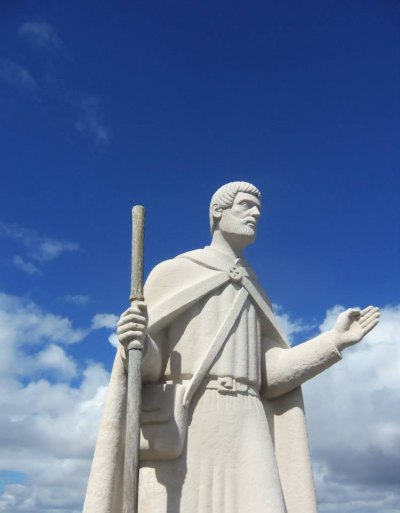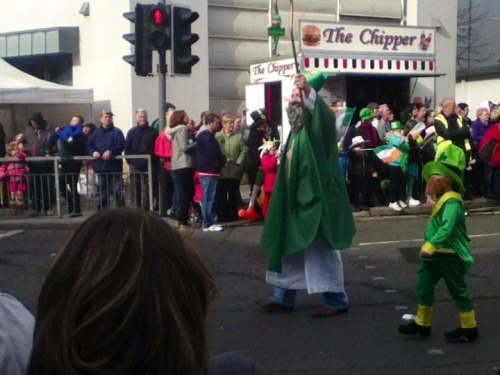Erin Go Bragh
Green beer, shamrocks, parties, parades, rainbows and leprechauns? Saint Patrick himself often seems low on the list.
The history of Saint Patrick is fascinating! Saint Patricius, Padraig, Padrig, or Patrick was a 5th century missionary in Ireland. When he was 16, he was captured by Irish pirates from his homeland Great Britian. He was taken as a slave to Ireland where he looked after animals for six years. He escaped and returned to Great Britain where he became a cleric. He returned to Northern and Western Ireland where later in life he became an ordained bishop.
It is hard to be certain about the details of Saint Patrick’s life. Separating the myth from facts proves difficult. My family and I spent two years living in Ireland before coming to Ocracoke and there are many places that claim that Saint Patrick traveled there, prayed there, or lived there. Of course we have all heard that he was responsible for driving snakes out of Ireland. I never saw a snake while I was living in Ireland so maybe that much is true.
One place associated with St. Patrick is Lough Derg in County Donegal. Richard and I had the privilege of visiting this beautiful place. Loch Dearg translates to Red Lake. The legend says that Saint Patrick killed a large serpent on this lake and it’s blood turned the lake red. When we visited Lough Derg, it was not red but a gorgeous blue. There is an island monastery there where pilgrims spend 3 days each August.
If you ever find yourself in County Donegal Ireland (one of the most beautiful places on earth), sign up for a pilgrimage to Station Island. What a way to celebrate Saint Patrick!
While we were in Ireland, we were definitely a minority being Protestant in a Catholic land. The town we lived in was 95% Catholic and just 5% Protestant! If you are thinking to yourself “Does that even matter anymore in 2016?” Yes it does! Things are still very segregated in parts of Ireland. We lived on the border and the city we lived in has been through very hard times. The “Troubles” were felt sharply there with many bombings and fear. Things are much better now but some of the fear and distrust remain.
Until the 1970s, pubs were closed on St. Patrick’s Day; the Irish are catching up to their counterparts across the pond when it comes to revelry. Since the mid-1990s, the government, in part to promote tourism and boost the economy, has sponsored a multi-day St. Patrick’s Festival in Dublin, featuring a parade and a variety of performances and activities; there are similar events in other sections of the country as well.
My family and I attended a St Patrick’s Day parade while living there. It was big, loud, festive and a lot of fun! Saint Patrick led the parade with many floats and groups following him. There were bands and Irish dancers and groups of children.
A few weeks later, we were chastised for attending this Catholic celebration. A St Patrick’s Day parade is one event that many Protestants in Ireland would never attend. (I wonder who saw us and tattled on us?) We were an American family living in Ireland – of course we wanted to go to a St Patrick’s Day parade!

- Attend a social gathering with traditional Irish music and dance. Some of the best craic, (pronounced crack) or fun, we had was when we sat in pubs and listened to the traditional musicians sing and play.
- Wear shamrocks. The Irish buy small pieces of living shamrocks at the corner stores and pin them to their jackets. They are wrapped in foil with soil and sold for about a dollar each at the register. Really neat! So go out in your garden and trim some clover or oxalis and sport it for the parade!
- Drink! They drink lots of beer (not green), usually dark or some of their traditional Irish whiskey. They take their alcohol very seriously.
- Wear green! From head to toe!
- (One bit of advice, if you are ever in Ireland, do NOT call it St. “Paddy’s” Day! They hate that!)
- Eat something Irish! Cabbage and bacon, a full Irish breakfast, GRAVY on everything!
- Go to church! St. Patrick’s Day is a serious religious holiday in Ireland.
- Go to a parade!!!
If you are on Ocracoke Island this year for Saint Patrick’s Day (March 17th), join in the parade!

The parade will begin at the Ocracoke Station (the gas station) at 1 pm and will proceed to the O’Bar (Ocracoke Bar and Grille, just down Hwy 12). There will be a single $550 cash prize for the best float, group or whimsical idea participating in the parade!
A list of the parade rules can be found at Ocracoke Station. While the registration deadline is March 15, last-minute entrants can bring their signed forms the day of the parade.
Angel the “Leprechaun” will be the grand marshal and judge of the parade this year. She will remain at the O’Bar until 5 pm for autographs and general Saint Patrick’s Day fun!
Check out these photos from Mary's travels around Ireland. She and her family lived there for two years.











